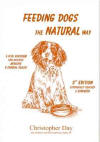Raw Feeding
|
|
|
|
Bone appetite...
|
|
Teasel
Pip
Beanie
Click here for Monica's
|
 I would also recommend
Feeding
Dogs The Natural Way, written by homoeopathic vet Christopher Day, MRCVS,Available
direct from
http://www.alternativevet.org/images/bookfeedingdogsthenaturalway-day.jpg £10.00
(including p&p. Cheques payable to C. Day)
I would also recommend
Feeding
Dogs The Natural Way, written by homoeopathic vet Christopher Day, MRCVS,Available
direct from
http://www.alternativevet.org/images/bookfeedingdogsthenaturalway-day.jpg £10.00
(including p&p. Cheques payable to C. Day)
It is 'An independent, objective and liberating analysis of the modern 'convenience' way of feeding our dogs and the penalties it brings. The simple, natural alternative is presented, which brings surprising and satisfying results in practice, both in health and in well-being of dogs. The author advocates using wholesome ingredients that a species suitable. Cooked or raw, plain or fancy, fresh is best.'
From Mandy Smith...
I also really enjoyed Monica Dixon's article on raw feeding as I feed my dogs a raw diet but instead of creating the meal myself I get my food from Green Dog Deli because they deliver a fresh, veterinary formulated complete raw diet that makes the whole thing really easy. http://www.greendogdeli.com/ (26/11/10)From Denise Scoffin...
I really enjoyed Monica Dixon's article on raw feeding I feed all my dogs a raw diet and they look and perform well on it. She has suggested things I haven't tried so very useful too. (22/11/10)From Christine Bailey...
As Monica says, there are many different ways to feed raw, and it really doesn't have to be complicated. The majority of raw feeders today include very little, if any, grain, and many do not feed fruit or veg; certainly many use no supplements at all.It's not clear to me from Monica's guidelines if these feed amounts are per meal or per day (though I would hope Teasel the Airedale gets more than 6oz of meat in a day!) so just to simplify it:-most dogs need between two and four percent of their bodyweight per day in food, 2.5 or 3 is a good place to start.
Remember you are trying to replicate the dog's prey. Think of a rabbit, pretty much the perfect doggie mealJ It is apparently roughly 10-12% bone, 10% offal, and the rest muscle meat (not counting the skin which you can feed if you wish) So that is what you are aiming for. A 20Kg dog would normally need around 500gm food per day. Food is meat, edible bone, offal, eggs, fish etc do not include any vegetables or fruit in the calculations, they are purely extras should you choose to feed them. Sorry, I've gone metricJ but 454gm is 1lb.
The only supplements I would give a normal healthy dog would be salmon oil and Vitamin E alongside it, though this is probably not necessary if you feed fish two or three times a week.
I'm not sure if Chris Day's book which indeed is the one I started out with has been updated, as in my 15-year-old copy he relies heavily on grains. I would suggest anyone interested in raw feeding has a good Google, and checks out Tom Lonsdale. The Yahoo Britbarf forum is very good for anyone considering raw feeding, too.
As an aside, it is not necessarily true that feeding raw makes your dog able to eat anything. One of mine is fine on raw, but not on cooked meat. Cooked chicken makes him very poorly but he is fine on raw. The only cooked food he tolerates is fish. (22/11/10)
 About
the author...
About
the author...
Monica Dixon's family have owned Airedale Terriers for at
least three generations on both the English and Swedish sides of her family. She currently has
one, nine-year-old Teasel, plus two Border Terriers, ten-year-old Beanie and two-year-old Pip
who is a rescue.
She appears to have started dog training aged about four, but it was not until she took early retirement from her job as PRO to The Jockey Club that she was able to have a dog of her own - an Airedale, of course - from the last litter bred by her Mother. One thing led to another and when her Mother died in 1991 she found herself living in a small London house with three of them.
A move back to the country was essential, initially to Surrey and now Hampshire, where she does Obedience, Agility and Heelwork to Music (see Beanie's YouTube clip: 'Crufts 2010 The Dancing Bean'). She is also a Pets As Therapy volunteer with Teasel and Beanie, making weekly visiting during term time to Treloars College, a unique further education college for severely disabled students, aged between 16-22.
Monica and Beanie won the Kennel Club Small Starters Cup at Discover Dogs 2010.
Published 21 November 2010
|
[bottom.htm] © Copyright Agilitynet |